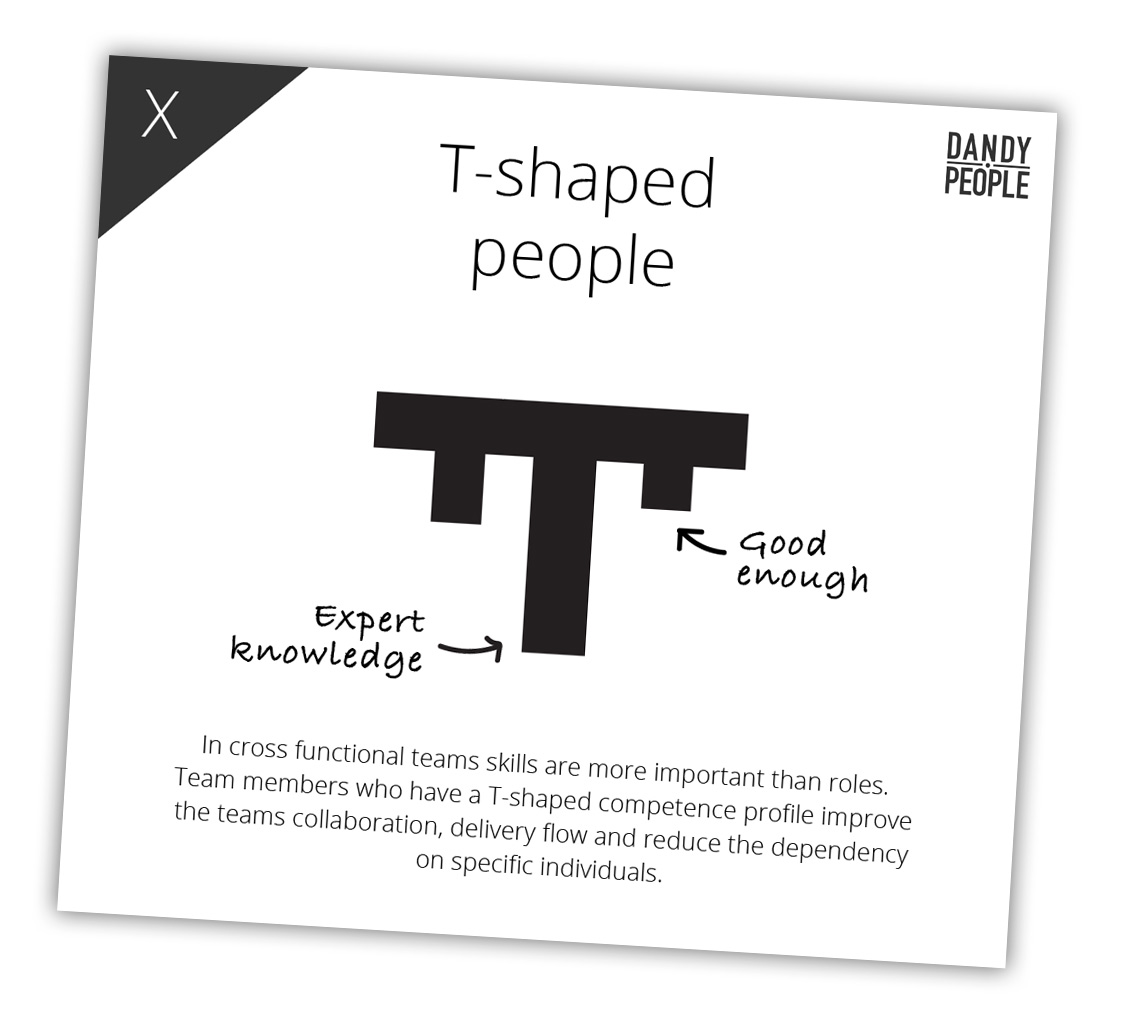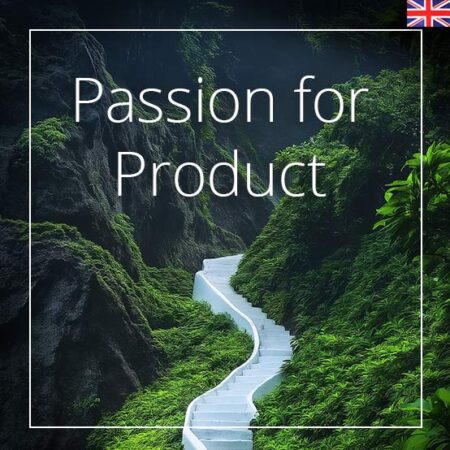 T-shape is about growing skills in people that might not be in within their core expert competence area. When coaching leaders, teams and organizations we’ve noticed that building T-shape is often a game changer that makes a big impact – but it might sometimes be more tricky than you think.
T-shape is about growing skills in people that might not be in within their core expert competence area. When coaching leaders, teams and organizations we’ve noticed that building T-shape is often a game changer that makes a big impact – but it might sometimes be more tricky than you think.
This is one of the 27 patterns for Successful Agile Change that you can download for free here >
When transforming to an Agile organization we often move from expert teams to cross functional teams. Growing t-shape is a way to enable the cross functional team to collaborate better and it helps them to work as a team instead of a group, meaning solving problems together instead of working as a mini-waterfall within the team. This helps the team become high performance and enables them to innovate and create better solutions.
Resistance to sharing competence and what to do about it
My experience is that organizations that have a strong expert culture may have more difficulties to become T-shape. Since you then might also need to change the culture from a hero culture to a team-playing culture, it can take some time. People might also struggle to keep their expert role since it makes them feel safe and perhaps it has also previously been the only way to make a career, get higher pay as well as also informal power. Changes might then be needed in how the structures are set up around roles and responsibilities before you start the coaching around T-shape.
In many organizations who want to enable high performance teams and T-shape, titels and roles are changed to simply “team members”, and instead we talk about competences, which is your T-shape. As a leader, you could support by help showing how the skill and performance of the team is more important than the expertise of individuals by perhaps celebrating as one team instead of highlighting individual performance.
Different leadership styles for developing skills in employees
In the Harvard Business Review I found this article that describes the research done on leaders and how they grow competence. According to their research there are 4 different leadership styles for developing skills in employees.
The different coaching styles of a leader:
- Teacher Managers coach employees on the basis of their own knowledge and experience, providing advice-oriented feedback and personally directing development. Many have expertise in technical fields and spent years as individual contributors before working their way into managerial roles.
- Always-on Managers provide continual coaching, stay on top of employees’ development, and give feedback across a range of skills. Their behaviors closely align with what HR professionals typically idealize. These managers may appear to be the most dedicated of the four types to upgrading their employees’ skills—they treat it as a daily part of their job.
- Connector Managers give targeted feedback in their areas of expertise; otherwise, they connect employees with others on the team or elsewhere in the organization who are better suited to the task. They spend more time than the other three types assessing the skills, needs, and interests of their employees, and they recognize that many skills are best taught by people other than themselves.
- Cheerleader Managers take a hands-off approach, delivering positive feedback and putting employees in charge of their own development. They are available and supportive, but they aren’t as proactive as the other types of managers when it comes to developing employees’ skills.
The 3rd style, the Connector, has according to HBR, proven to be the most successful style to grow needed competences in employees.
About the Research: “Coaching vs. Connecting: What the Best Managers Do to Develop Their Employees Today,” by Gartner (white paper)
Coaching techniques to enable T-shaped employees
This is similar to the how we see that an Agile leader need to coach their employees to enable well functioning competence development in autonomous Agile teams. Here are two coaching tools that I’ve found very helpful over the years doing this.
The X-team Silos Game – experienced based training
When working with change we like to help people not just learn something new, but first experience something new. The experience help people to much easier understand why the change is needed, as well as making it easier for them to also know how it feels when it is working in a good way. This is an experience based game created by me and my former colleague Per Lundholm, as a part of our training for x-functional teams. The idea behind the game was to help team experience and understand the difference between working only with their core expertise and how it is when you help and grow your team mates T-shape and competences so that the whole team learn a bit from every one else. The T-shaped team outperformes the team that works only in their expert roles by far, and it also feels much more fun when the team can work on tactics together to deliver. We have played the game many times with different teams and in different organizations and the discussions might be a bit different dependent on their real situation, always with great result helping teams to get started in their journey to collaborate and build new knowledge.
Here you can read more about X-team Silos Game >
Exploring T-shapes – self assessment
As a follow up on the X-team Silos Game I usually do some kind of a exploration of peoples true T-shapes, the different skills they have and how they would grade themselves.
This is a suggestion on how you can do the self assessment workshop
- First create personal T-shape posters
Ask every one to create their own T-Shape poster on a big A1 paper. .The poster should contain their name, and 5 horisontal levels;
5. Expert (could write a book about it)
4. Do it all the time (can teach others)
3. Good enough (can do it by my self)
2. Newbie (need support)
1. Want to learn
2. Share skills
Ask everyone to write down what skills they think their team mates have for about 10 minutes. This is usually a great warm-up for the team. When doing this you can either ask for hard skills, or soft skills, or just let them do as they please. In new teams or with new team-members they might not know the hard skills, but soft skills might be easy and safe as well as a great team building exercise. A hard skill is what you use in your work, a soft skill is a behaviour you have that might be important for the team as well. Then ask them to read them up and give them to each team member. And they can if they like add these skills to their own poster where they seem it fit.
3. Your own skills
Ask them to write down their own hard skills one and one on stickies for about 10 minutes. And then ask them to put each skill in the grading they think it fits. If they think they are good enough on a skill they put it on #3 and so on. When all are done in each team, ask them to present their poster to the others in their team. Usually this is quite fun, and other team members might also want to give their team members new skills that they see are missing, or they might not agree on someones grading, usually to the favor a higher rating.
If you are facilitation several teams you can walk around and observe how the teams are doing, what conversations they have and how the mood in the teams are.
Ask them to put them on the wall and do a gallery walk – have them walk around and look at each others posters, between the teams as well. When doing this you can ask them to keep an eye on who could possibly help them to grow the skills they want to grow, it could be someone in their own team, or someone else.
Now all team members have their own T-shape poster and they should keep it, since this is just the start of your T-shape journey 🙂
As a follow up on this off course there could be several things you can do, perhaps setting missions for the teams and what skills are needed in each team, having all teams visualize their team members T-shape on their team board, and off course getting started with team activities to start sharing skills with each other, such as mobb-and pair work or starting up competence sharing groups.
This is one of the 27 patterns for Successful Agile Change that you can download for free here >



